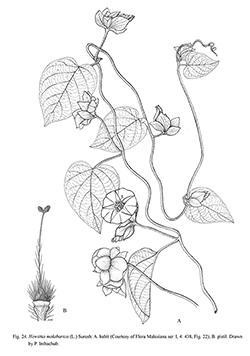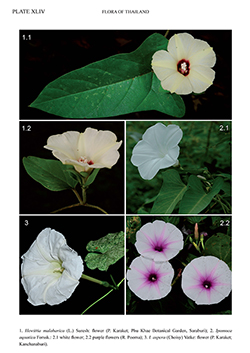e-Flora of Thailand
Volume 10 > Part 3 > Year 2010 > Page 401 > Convolvulaceae > Hewittia
Hewittia malabarica (L.) Sureshwfo-0001298969
Interp. Rheede Hort. Malab. 88. 1988; R.C.Fang & Staples in C.Y.Wu & P.H.Raven, Fl. China 16: 285. 1995.— Convolvulus malabaricus L., Sp. Pl. 1: 155. 1753. Fig. 24; Plate XLIV: 1.
Accepted Name : This is currently accepted.
Synonyms & Citations :
Description : Perennial herbs; stems twining or prostrate, 1–2 m, occasionally rooting at nodes; rather densely pubescent. Leaves ovate to hastate, 3–10 by 3–8 cm, appressed pilose or subglabrous, upper side minutely and sparsely verrucate, base cordate, hastate, or truncate, margins entire, angled or 3-lobed, apex acuminate to acute, mucronate; petiole 1-6 cm. Inflorescence peduncle 1.5–10 cm; bracts oblong-lanceolate, 7–15 mm, persistent; pedicel 2–4 mm. Flower: sepals unequal, pubescent outside, accrescent, outer 3 broadly ovate, 9–15 by 6–9 mm, to 17 mm in fruit; inner 2 oblong-lanceolate, smaller; corolla 2–2.5 cm long, pale yellow or whitish, centre purple, midpetaline bands pilose outside; stamens ca 9 mm long, filaments basally papillose, anthers ovoid-deltoid; ovary villous. Capsule depressed globose, 8–10 mm diam., tardily dehiscent, the 4 valves splitting into smaller segments. Seeds ovoid-trigonous, 4–6 mm, brown to dull black, scurfy, hilum pubescent.
Thailand : NORTHERN: Chiang Mai, Nan, Lamphun, Lampang, Phrae, Phitsanulok, Kamphaeng Phet, Nakhon Sawan; NORTH-EASTERN: Phetchabun, Khon Kaen; EASTERN: Chaiyaphum, Nakhon Ratchasima; SOUTH-WESTERN: Kanchanaburi, Prachuap Khiri Khan; CENTRAL: Saraburi, Krung Thep Maha Nakhon (Bangkok); SOUTH-EASTERN: Prachin Buri, Chon Buri, Chanthaburi; PENINSULAR: Surat Thani, Nakhon Si Thammarat, Trang, Yala.
Distribution : India (type), Sri Lanka, Myanmar, China, Laos, Cambodia, Vietnam, Malaysia, Indonesia, New Guinea, the Philippines; also widespread in tropical Africa, Jamaica and the Pacific Islands.
Ecology : Often a plant of disturbed areas near human habitation: roadsides, coconut plantations, agricultural fields, waste places, as well as in disturbed areas, in the edges or clearings of evergreen forests, disturbed forests, deciduous forests, and in brushy thickets, near sea level to 850 m alt. Flowering: January, April, August, September–November; fruiting: January, February, April, October–December.
Vernacular : Ching cho lek (จิงจ้อเล็ก), thao ching cho (เถาจิงจ้อ)(Prachuap Khiri Khan); cha ching cho (ช้าจิงจ้อ)(Chon Buri).
Notes: The capsules appear to dehisce tardily, the 4 valves separating except at the apex; each valve again tears longitudinally at several points, but the tears don't reach the apex. The whole fruit at this stage has a latticed look, with the seeds still trapped inside.


